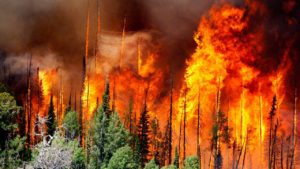
Context
Since the start of 2021, there has been a series of forest fires in Himachal Pradesh, Nagaland-Manipur border, Odisha, Madhya Pradesh, and Gujarat, including in wildlife sanctuaries.
Why in news?
Uttarakhand has witnessed over 1,000 incidents of forest fire over the last six months, including 45 in the last 24 hours alone, and has reached out to the Centre for helicopters and personnel from the National Disaster Response Force (NDRF). At least five persons and seven animals have been reported killed.
About
- Since the start of 2021, there has been a series of forest fires in Himachal Pradesh, Nagaland-Manipur border, Odisha, Madhya Pradesh, and Gujarat, including in wildlife sanctuaries.
- April-May is the season when forest fires take place in various parts of the country.
- But forest fires have been more frequent than usual in Uttarakhand and have also taken place during winter; dry soil caused by a weak monsoon is being seen as one of the causes.
Where have forest fires happened?
January saw prolonged fires in Uttarakhand, Himachal Pradesh (Kullu Valley) and Nagaland-Manipur border (Dzukou Valley). The ongoing one in Nainital began in March-end. The Simlipal National Park in Odisha saw a major fire between February-end and early March.
Recent fires include those in Bandhavgarh Forest Reserve in Madhya Pradesh, and in sanctuaries for the Asiatic lion and the great Indian bustard in Gujarat.
How prone to fire are India’s forests?
- As of 2019, about 21.67% (7,12,249 sq km) of the country’s geographical area is identified as forest, according to the India State of Forest Report 2019 (ISFR) released by the Forest Survey of India (FSI), Dehradun.
- Tree cover makes up another 2.89% (95, 027 sq km).
- Based on previous fire incidents and recorded events, forests of the Northeast and central India regions are the most vulnerable areas to forest fires, the FSI has said.
- Forests in Assam, Mizoram and Tripura have been identified as ‘extremely prone’ to forest fire. States with large forest areas under the ‘very highly prone’ category include Andhra Pradesh, Manipur, Meghalaya, Mizoram, Nagaland, Odisha, Maharashtra, Bihar and Uttar Pradesh.
- Western Maharashtra, Southern Chhattisgarh and areas of Telangana and Andhra Pradesh, along with central Odisha, are turning into ‘extremely prone’ forest fire hotspots, the 2020-2021 annual report of the MoEFCC.
- Areas under the ‘highly prone’ and ‘moderately prone’ categories make up about 26.2% of the total forest cover — a whopping 1,72,374 sq km.
How vulnerable are forests in Uttarakhand?
Uttarakhand and Himachal Pradesh are the two states that witness the most frequent forest fires annually. In Uttarkhand, 24,303 sq km (over 45 per cent of the geographical area) is under forest cover.
The FSI has identified forests along the south, west and southwest regions of Uttarakhand — comprising Dehradun, Hardwar, Garhwal, Almora, Nainital, Udham Singh Nagar, Champawat districts — as being prone to varying intensities of forest fires.
What causes forest fires?
- Forest fires can be caused by a number of natural causes, but officials say many major fires in India are triggered mainly by human activities. Emerging studies link climate change to rising instances of fires globally, especially the massive fires of the Amazon forests in Brazil and in Australia in the last two years.
- Fires of longer duration, increasing intensity, higher frequency and highly inflammable nature are all being linked to climate change.
- In India, forest fires are most commonly reported during March and April, when the ground has large quantities of dry wood, logs, dead leaves, stumps, dry grass and weeds that can make forests easily go up in flames if there is a trigger.
- Under natural circumstances, extreme heat and dryness, friction created by rubbing of branches with each other also have been known to initiate fire.
- In Uttarakhand, the lack of soil moisture too is being seen as a key factor. In two consecutive monsoon seasons (2019 and 2020), rainfall has been deficient by 18% and 20% of the seasonal average, respectively.
- But, forest officials say most fires are man-made, sometimes even deliberately caused.
- Even a small spark from a cigarette butt, or a carelessly discarded lit matchstick can set the fire going.
- For example, in Odisha, which saw a major fire last month in Simlipal forest, villagers are known to set dry leaves to fire in order to collect mahua flowers, which go into preparation of a local drink.
Why are forest fires difficult to control?
- The locality of the forest and access to it pose hurdles in initiating firefighting efforts. During peak season, shortage of staff is another challenge in dispatching firefighting teams.
- Timely mobilisation of forest staff, fuel and equipment, depending on the type of fire, through the thick forests remain challenges.
- As it is impossible to transport heavy vehicles loaded with water into the thick forests, a majority of fire dousing is initiated manually, using blowers and similar devices.
- But there have been incidents when forest fires were brought under control using helicopter services.
- Wind speed and direction play a critical role in bringing a forest fire under control. The fire often spreads in the direction of the winds and towards higher elevations.

